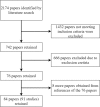"Female Preponderance" of Depression in Non-clinical Populations: A Meta-Analytic Study
- PMID: 27695433
- PMCID: PMC5023676
- DOI: 10.3389/fpsyg.2016.01398
"Female Preponderance" of Depression in Non-clinical Populations: A Meta-Analytic Study
Abstract
Clinical observations and research suggest a female preponderance in major depressive disorder. However, it is unclear whether a similar gender difference is found for the reporting of depressive symptoms in non-clinical populations. The present meta-analysis was conducted to address this issue. We searched for published papers targeting non-clinical populations in which the 21-item Beck Depression Inventory (BDI) was used. Eighty-four papers (91 studies) published between 1977 and 2014 were included in the final meta-analysis, which comprised 23,579 males and 29,470 females. Females in the general population reported higher level of depressive symptoms than males (d = -0.187, corresponding to 1.159 points in the 21-item BDI). This pattern was not found to influence by years of publication, socioeconomic status, or version of the BDI used. Using age group as a moderator, studies with adolescents and young adults were found to show a smaller effect size than studies with older participants. Our results appear to confirm the "female preponderance" in the level of self-report depressive symptoms in the general population, and support the social gender role theory in explaining gender difference over biological susceptibility theory and evolutionary theory.
Keywords: BDI; age; depression; economic status; gender difference; social gender role.
Figures



References
-
- Aalto A. M., Elovainio M., Kivimaki M., Uutela A., Pirkola S. (2012). The Beck Depression Inventory and general health questionnaire as measures of depression in the general population: a validation study using the composite international diagnostic interview as the gold standard. Psychiatry Res. 197 163–171. 10.1016/j.psychres.2011.09.008 - DOI - PubMed
Publication types
LinkOut - more resources
Full Text Sources
Other Literature Sources
Molecular Biology Databases

